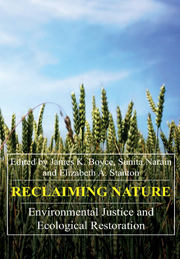Book contents
- Frontmatter
- Contents
- List of Figures and Tables
- Acknowledgements
- Introduction
- Part I ADDING VALUE
- Part II DEMOCRATIZING ACCESS
- 5 Land Reform and Sustainable Development
- 6 Extractive Reserves: Building Natural Assets in the Brazilian Amazon
- 7 Mining Rights and Community Rights: Poverty amidst Wealth
- 8 Natural Assets and Participatory Forest Management in West Africa
- Part III CAPTURING BENEFITS
- Part IV DEFENDING THE COMMONS
- About the Contributors
- Index
5 - Land Reform and Sustainable Development
from Part II - DEMOCRATIZING ACCESS
Published online by Cambridge University Press: 05 March 2012
- Frontmatter
- Contents
- List of Figures and Tables
- Acknowledgements
- Introduction
- Part I ADDING VALUE
- Part II DEMOCRATIZING ACCESS
- 5 Land Reform and Sustainable Development
- 6 Extractive Reserves: Building Natural Assets in the Brazilian Amazon
- 7 Mining Rights and Community Rights: Poverty amidst Wealth
- 8 Natural Assets and Participatory Forest Management in West Africa
- Part III CAPTURING BENEFITS
- Part IV DEFENDING THE COMMONS
- About the Contributors
- Index
Summary
Introduction
In agricultural economies, land is the single most important asset. With access to arable land, rural people at a minimum can feed themselves and their families. Yet ironically, world hunger is concentrated in the countryside. The United Nations Food and Agriculture Organization (FAO 2004, 25) reports that land-poor and landless households in rural areas account for 80 per cent of the people who are chronically hungry in the world today.
Land reform — here defined as the reallocation of rights to establish a more equitable distribution of farmland — can be a powerful strategy for promoting both economic development and environmental quality. Across the globe, small-scale farmers consistently tend to grow more output per acre than large farms. At the same time, when small family farmers hold secure land rights, they tend to be better environmental stewards, protecting and enhancing soil fertility, water quality and biodiversity. For both reasons, democratizing access to land can be the cornerstone for sustainable rural development.
This chapter provides an overview of land reform as a natural assetbuilding strategy. First, we sketch the wide variety of changes in agrarian structure that fall under the rubric of ‘land reform’. To illustrate, we review the experiences of China, Japan, Korea and Taiwan after World War II, where land reforms helped to set the stage for rapid economic growth. We then describe of one of the most vibrant land reform movements of the present day: the Landless Workers' Movement of Brazil.
- Type
- Chapter
- Information
- Reclaiming NatureEnvironmental Justice and Ecological Restoration, pp. 127 - 150Publisher: Anthem PressPrint publication year: 2007



